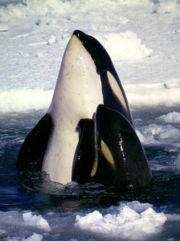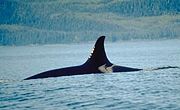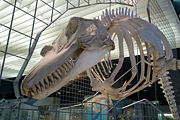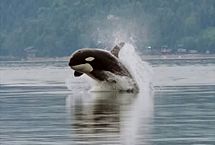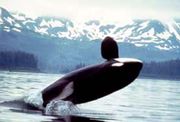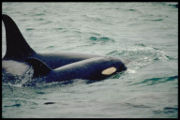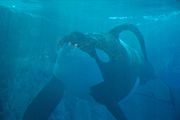Orca
2008/9 Schools Wikipedia Selection. Related subjects: Mammals
| Orca | ||||||||||||||||
|---|---|---|---|---|---|---|---|---|---|---|---|---|---|---|---|---|
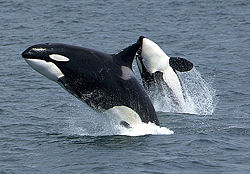 Transient Orcas near Unimak Island, eastern Aleutian Islands, Alaska  Size comparison against an average human
|
||||||||||||||||
| Conservation status | ||||||||||||||||
| Scientific classification | ||||||||||||||||
|
||||||||||||||||
| Binomial name | ||||||||||||||||
| Orcinus orca Linnaeus, 1758 |
||||||||||||||||
 Orca range (in blue)
|
The Orca or Killer Whale (Orcinus orca), less commonly, Blackfish or Seawolf, is the largest species of the oceanic dolphin family. It is found in all the world's oceans, from the frigid Arctic and Antarctic regions to warm, tropical seas.
Orca are versatile and opportunistic predators. Some populations feed mostly on fish, and other populations hunt marine mammals, including sea lions, seals, and even large whales. There are up to five distinct Orca types, some of which may be separate races, subspecies or even species. Orcas are highly social; some populations are composed of matrilineal family groups which are the most stable of any animal species. The sophisticated social behaviour, hunting techniques, and vocal behaviour of Orcas have been described as manifestations of culture.
Although Orcas are not an endangered species, some local populations are considered threatened or endangered due to pollution, depletion of prey species, conflicts with fishing activities and vessels, habitat loss, and whaling. Wild Orcas are usually not considered a threat to humans. There have, however, been isolated reports of captive Orcas attacking their handlers at marine theme parks.
Taxonomy and evolution
The sole species in the genus Orcinus, the Orca was one of the many species originally described by Linnaeus in 1758 in Systema Naturae. It is one of thirty-five species in the dolphin family. Like the Sperm Whale genus Physeter, Orcinus is a genus with a single, abundant species. Thus, paleontologists believe that the Orca is a prime candidate to have an anagenetic evolutionary history, forming descendant species from ancestral species without splitting of the lineage. If true, this would make the Orca one of the oldest dolphin species. However, it is unlikely to be as old as the family itself, which is believed to date back at least five million years.
However, there are at least three to five types of Orcas that are distinct enough to be considered different races, subspecies, or possibly even species. In the 1970s and 1980s, research off the west coast of Canada and the United States identified the following three types:
- Resident: These are the most commonly sighted of the three populations in the coastal waters of the northeast Pacific, including Puget Sound. The resident Orcas' diet consists primarily of fish and sometimes squid and they live in complex and cohesive family groups. Pods possess lifelong family bonds often living in large matrilineal groups and vocalizing in highly variable and complex "dialects." "The basic unit of resident Orca society is a mother, all of her dependent offspring (approximately ten years or younger), and her adult offspring as well, including her sons. Females will eventually spend less time with their mothers, as they begin producing calves of their own, but resident males appear to remain with their mothers for their entire lives. They leave for short periods to mate outside of their maternal group, but return to their mother afterwards." Female residents characteristically have a rounded dorsal fin tip that terminates in a sharp corner. They are known to visit the same areas consistently. The resident populations of British Columbia, and Washington are amongst the most intensely studied marine mammals ever. Researchers have identified and named over 300 Orcas over the past 30 years.
- Transient: The diet of these Orcas consists almost exclusively of marine mammals; they do not eat fish. Transients in southern Alaska generally travel in small groups, usually of two to six animals. Unlike residents, transients may not always stay together as a family unit. Pods consist of smaller groups with less persistent family bonds and vocalizing in less variable and less complex dialects. Female transients are characterized by dorsal fins that are more triangular and pointed than those of residents. The gray or white area around the dorsal fin, known as the saddle patch, often contains some black coloring in residents. However, the saddle patches of transients are solid and uniformly gray. Transients roam widely along the coast – some individuals have been sighted in Southern Alaska and later in California
- Offshore: These Orcas were discovered in 1988 when a humpback whale researcher signaled to Orca researchers Michael Bigg and Graeme Ellis that he saw Orcas in open water. These Orcas cruise the open oceans and feed primarily on fish, sharks and sea turtles. They have been seen traveling in groups of up to 60 animals. Currently there is little known about the habits of this population, but they can be distinguished genetically from the residents and transients. Female offshores are characterized by dorsal fin tips that are continuously rounded.
Orca populations in other parts of the world have not been as well-studied. However, there appears to be a correlation between a population's diet and its social behaviour. Fish-eating Orcas in Alaska and Norway have also been observed to have resident-like social structures. Mammal-eating Orcas in Argentina and the Crozet Islands have been observed to behave more like transients.
Transient and resident Orcas live in the same areas, but avoid each other. The name "transient" originated from the belief that these Orcas were outcasts from larger resident pods. Researchers later discovered that transients are not born into resident pods, or vice-versa. The evolutionary split between the two groups is believed to have begun two million years ago. Recent genetic research has found that the types have not interbred for up to 10,000 years.
Three Orca types have recently been documented in the Antarctic.
- Type A looks like a "typical" Orca, living in open water and feeding mostly on Minke Whales.
- Type B is smaller than Type A. It has a large white eyepatch and a patch of grey colouring on its back, called a dorsal cape. It feeds mostly on seals.
- Type C is the smallest type and lives in larger groups than any other type of Orca. Its eyepatch is distinctively slanted forwards, rather than parallel to the body axis. Like Type B, it has a dorsal cape. Its only prey observed so far is the Antarctic toothfish.
Type B and C Orcas live close to the Antarctic ice pack, and diatoms in these waters may be responsible for the yellowish colouring of both types. Research is ongoing whether Type B and C Orcas are different species.
Common names
The name "Orca" (plural "Orcas") was originally given to these animals by the ancient Romans, possibly borrowed from the Greek word ὄρυξ which (among other things) referred to a species of whale. The term "orc" (or its variant "ork") has been used to describe a large fish, whale or sea-monster. It is now considered an obsolete equivalent for "Orca."
The name "killer whale" is widely used in common English. However, since the 1960s, "Orca" has steadily grown in popularity as the common name to identify the species, and both names are now used. This change partly due to a desire by some to remove their reputation as "killers". The species is called Orca in most other European languages , and, as there has been a steady increase in the amount of international research on the species, there has been a convergence in naming.
Supporters of the original name point out that the naming heritage is not limited to Spanish sailors. Indeed the genus name "Orcinus" means "from Hell" (see Orcus), and although the name "Orca" (in use since antiquity) is probably not etymologically related, the assonance might have given some people the idea that it meant "whale that brings death," or "demon from hell." The name is also similar to " Orcus" the Roman god of the underworld.
The name of this species is similarly intimidating in many other languages, including Finnish, Dutch, German, Haida, Japanese and Chinese.
They are sometimes referred to as blackfish, a name also used to refer to pilot whales, pygmy and false killer whales, and melon-headed whales. A former name for the species is grampus. This is now seldom used and should not be confused with the Grampus genus, whose only member is Risso's Dolphin.
Description
Orcas are distinctively marked, with a black back, white chest and sides, and a white patch above and behind the eye. Calves are born with a yellowish or orange tint, which fades to white. Orcas have a heavy and stocky body and a large dorsal fin with a dark grey "saddle patch" at the fin's rear. Antarctic Orcas may have pale grey to nearly white backs. Males typically range from 6-8 metres long (19-26 ft) and weigh in excess of 6 tonnes. Females are smaller, generally ranging from 5-7 m (16-23 ft) and a weight of about 4 to 5 tonnes. However, an adult Orca's weight can be anywhere from 2,585 to 7,257 kg (5,700 to 16,000 lb), although males are heavier than females. The largest Orca ever recorded was a male off the coast of Japan, measuring 9.8 m (32 ft) and weighed over 8 tonnes(17,636 lb). Calves at birth weigh about 180 kg (350-500 lb) and are about 2.4 m long (6-8 ft). The Orca's large size and strength make them among the fastest marine mammals, often reaching speeds in excess of 56 km/h (35 mph).
Unlike most dolphins, the pectoral fin of an Orca is large and rounded — more of a paddle than other dolphin species. Males have significantly larger pectoral fins than females. At about 1.8 m (6 ft), the dorsal fin of the male is more than twice the size of the female's, and is more of a triangle shape — a tall, elongated isosceles triangle, whereas the dorsal fin of the female is shorter and generally more curved.
Adult male Orcas are very distinctive and are unlikely to be confused with any other sea creature. When seen from a distance in temperate waters, adult females and juveniles can be confused with various other species, for example the False Killer Whale or Risso's Dolphin.
Individual Orcas can be identified from a good photograph of the animal's dorsal fin and saddle patch, taken when it surfaces. Variations such as nicks, scratches, and tears on the dorsal fin, and the pattern of white or grey in the saddle patch, are sufficient to distinguish Orcas from each other. For the well-studied Orcas of the northeast Pacific, catalogues have been published with the photograph and name of each Orca. Photo-identification has enabled the local population of Orcas to be counted each year rather than estimated, and has enabled great insight into Orca lifecycles and social structures.
Lifecycle
Females become mature at around 15 years of age. Then they have periods of polyestrous cycling with non-cycling periods of between three and sixteen months. The gestation period varies from fifteen to eighteen months. Mothers calve, with a single offspring, about once every five years. In analysed resident pods, birth occurs at any time of year, with the most popular months being those in winter. Newborn mortality is very high — one survey suggested that nearly half of all calves fail to reach one year old. Calves nurse for up to two years, but will start to take solid food at about twelve months. All resident Orca pod members, including males of all ages, participate in the care of the young.
Cows breed until the age of 40, meaning that on average they raise five offspring. Typically, females' life span averages 50, but may survive well into their 70-80s in exceptional cases. Males become sexually mature at the age of 15, but do not typically reproduce until age 21. Male Orcas generally don't live as long as females. In the wild, males average 30 years with a maximum of 50–60 years in exceptional cases. However, one male, known as ‘Old Tom’ was reportedly spotted every winter between 1843 and 1932 off New South Wales, Australia. This would have made him at least 89 years old. The lifespans of captive Orcas are significantly shorter, usually less than 25 years.
White orca have been spotted in the northern Bering Sea and around St. Lawrence Island. Also there have been sightings along the Russian coast.
In February of 2008, A white orca was photographed two miles (3 km) off Kanaga Volcano. The whale was a healthy, adult male about 25 to 30 feet (9.1 m) long and weighing upward of 10,000 pounds.
Distribution
Orcas are found in all oceans and most seas, including (unusually for cetaceans) the Mediterranean and Arabian seas. However, they prefer cooler temperate and polar regions. Although sometimes spotted in deep water, coastal areas are generally preferred to pelagic environments.
The Orca is particularly highly concentrated in the north-east Pacific Basin, where Canada curves into Alaska, off the coast of Iceland and off the coast of northern Norway. They are regularly sighted in Antarctic waters right up to the ice-pack and are believed to venture under the pack and survive breathing in air pockets like the beluga does. In the Arctic, however, the species is rarely seen in winter, as it does not approach the ice pack. It does visit these waters during summer.
Information for off-shore regions and tropical waters is more scarce, but widespread, if not frequent, sightings indicate that the Orca can survive in most water temperatures. Sightings are rare in Indonesian and Philippine waters. No estimate for the total worldwide population exists. Local estimates include 70–80,000 in the Antarctic, 8,000 in the tropical Pacific (although tropical waters are not the Orca's preferred environment, the sheer size of this area — 19 million square kilometres — means there are thousands of Orcas), up to 2,000 off Japan, 1,500 off the cooler north-east Pacific and 1,500 off Norway. Adding very rough estimates for unsurveyed areas, the total population could be around 100,000.
With the rapid decline of Arctic sea ice in the Hudson Strait, the range of Orcas has now extended into the far northern waters of Canada. Through the 1990s, Orcas were sighted in western Hudson Bay at a rate of six per decade; sightings rose to more than 30 between 2001–2006.
The migration patterns of Orcas are poorly understood. Each summer, the same resident Orcas appear off the coasts of British Columbia and Washington State. After decades of research, it is still unknown where these animals go for the rest of the year.
Scientists spotted a white killer whale off Alaska on February 23, 2008.
Diet
The Orca is an apex predator. They are sometimes called the wolves of the sea because they hunt in packs like wolves. On average, an Orca eats 227 kg (500 lb) of food each day.
Orcas prey on a diverse array of species. However, specific populations show a high degree of specialization on particular prey species. For example, some populations in the Norwegian and Greenland sea specialise in herring and follow that fish's migratory path to the Norwegian coast each autumn. Other populations in the area prey on seals. In field observations of the resident Orcas of the northeast Pacific, salmon accounted for 96% of animals' diet, with 65% of the salmon being the large, fatty Chinook. They have been observed to swim through schools of the smaller salmon species without attacking any of them. Depletion of specific prey species in an area is therefore cause for concern for the local Orca population, despite the high overall diversity of potential Orca prey.
Although, unlike transient Orcas, resident Orcas have never been observed to eat other marine mammals, they are known to occasionally harass and kill porpoises and seals for no apparent reason.
Fish and other cold-blooded prey
Fish-eating Orcas prey on 30 species of fish, particularly salmon (including Chinook and Coho), herring, and tuna, as well as basking sharks, oceanic whitetip sharks and smooth hammerheads. In one incident, off the Farallon Islands a subadult great white shark was killed by a mother Orca protecting her calf. The calf then ate the shark's nutrient-rich liver. There is also a known Orca that has been documented to specifically hunt great white sharks, eating the liver as a source of food. In New Zealand Orcas have been observed hunting stingrays as well. Cephalopods, such as octopuses and a wide range of squids, and reptiles, such as sea turtles, are also targets.
While salmon are usually hunted by a single Orca or a small group of individuals, herring are often caught using carousel feeding: the Orcas force the herring into a tight ball by releasing bursts of bubbles or flashing their white undersides. The Orcas then slap the ball with their tail flukes, either stunning or killing up to 10–15 herring with a successful slap. The herring are then eaten one at a time. Carousel feeding has only been documented in the Norwegian Orca population and with some oceanic dolphin species.
Mammal prey
Twenty-two cetacean species have been recorded as preyed on by Orcas, either through an examination of stomach contents, examining scarring on the prey's body, or from observing the Orcas' feeding activity. Groups of Orcas attack even larger cetaceans such as Minke Whales, Gray Whales, and very occasionally Sperm Whales or Blue Whales. Orcas generally choose to attack whales which are young or weak. However, a group of five or more Orcas may attack healthy adult whales. Bull Sperm Whales are avoided, as they are large, powerful, and aggressive enough to kill Orcas.
When hunting a young whale, a group chases it and its mother until they are worn out. Eventually the Orcas manage to separate the pair and surround the young whale, preventing it from returning to the surface to breathe. Whales are typically drowned in this manner. Pods of female Sperm Whales can sometimes protect themselves against a group of Orcas by forming a protective circle around their calves with their flukes facing outwards. This formation allows them to use their powerful flukes to repel the Orcas. Hunting large whales, however takes a lot of time, usually several hours. Orca cannibalism has also been reported.
Other marine mammal prey species include most species of seal, sea lion and fur seal. Walruses and Sea otters are taken less frequently. Orcas often use complex hunting strategies to find and subdue their prey. Sea lions are killed by head-butting or by being slapped and stunned by a tail fluke. They occasionally throw seals through the air in order to stun and kill them. Often, to avoid injury, they disable their prey before killing and eating it. This may involve throwing it in the air, slapping it with their tails, ramming it, or breaching and landing on it.
Some highly specialized hunting techniques have been observed. Off Península Valdés, Argentina and the Crozet Islands, Orcas feed on South American sea lions and Southern elephant seals in shallow water; even beaching themselves temporarily. Beaching, usually fatal to whales, is not an instinctive behaviour. Adult Orcas have been observed to teach the younger ones the skills of hunting in shallow water. Off Península Valdés, adults pull seals off the shoreline for younger Orcas to recapture. Off the Crozet Islands, mothers have been seen pushing their calves onto the beach, waiting to pull the youngster back if needed.
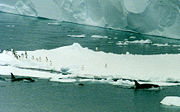
Another technique for capturing seals is known as wave-hunting: Orcas spy-hop to locate Weddell seals, Ross seals, Crabeater seals and Leopard seals resting on ice floes, and then create waves by swimming together in groups to wash over the floe. This causes the seal to be thrown into the water where another Orca waits to kill it. The most recent recorded instance in April 2006 ended with the group of Orcas actually returning the seal to the ice floe after they had shown the younger animals how to properly perform the technique.
Orcas have also been observed preying on terrestrial mammals, such as deer and moose, swimming between islands off the northwest coast of North America.
Birds
Several species of bird are preyed upon, including penguins, cormorants and sea gulls. A captive Orca in Friendship Cove discovered that it could regurgitate fish onto the surface, attracting sea gulls, and then eat them. Other Orcas then learned the behaviour by example.
Behaviour
There are at least two types of general Orca behaviour: Resident and transient. Each type also has different food sources.
The day-to-day behaviour of Orcas is generally divided into four activities: foraging, travelling, resting and socializing. Orcas are generally enthusiastic in their socializing, engaging in behaviours such as breaching, spyhopping, and tail-slapping.
Resident Orcas can also be seen swimming with porpoises, other dolphins, seals, and sea lions, which are common prey for transient Orcas. Resident Orcas are continually on the move, sometimes traveling as much as 160 km (100 miles) in a day, but may be seen in a general area for a month or more. Range for Resident Orca pods may be as much as 1300 km (800 miles) or as little as 320 km (200 miles).
Social structure of Resident Orca communities
Fish-eating Orcas in the North Pacific have a complex but extremely stable system of social grouping. Unlike any other mammal species whose social structure is known, Resident Orcas of both genders live with their mothers for their entire lives. Therefore, Orca societies are based around matrilines consisting of a single female (the matriarch) and her descendants. The sons and daughters of the matriarch form part of the line, as do the sons and daughters of those daughters. The average size of a matriline is nine animals.
Because females can live for up to ninety years, it is not uncommon for four or even five generations to travel together. These matrilineal groups are highly stable. Individuals split off from their matrilineal group only for up to a few hours at a time, in order to mate or forage. No permanent casting-out of an individual from a matriline has ever been recorded.
Closely-related matrilines form loose aggregations called pods, consisting on average of about 18 animals. All members of a pod use a similar set of calls, known as a dialect. Unlike matrilines, pods may split apart for days or weeks at a time in order to forage. Orcas within a pod do not interbreed; mating occurs only between members of different pods.
Resident pods have up to 50 or more members. Occasionally, several pods join to form "superpods," sometimes with more than 150 animals. Resident pods often include subpod which comprises one daughter or cousin that sometimes travels only with her offspring and sometimes join the rest of the pod.
The next level of grouping is the clan. A clan consists of pods which have a similar dialect. Again the relationship between pods appears to be genealogical, consisting of fragments of families with a common heritage on the maternal side. Different clans can occupy the same geographical area; pods from different clans are often observed travelling together. When Resident pods come together to travel as a clan, they greet each other by forming two parallel lines akin to a face-off before mingling with each other.
The final layer of association, perhaps more arbitrary and devised by humans rather than the other very natural divisions, is called the community and is loosely defined as the set of clans that are regularly seen mixing with each other. Communities do not follow discernible familial or vocal patterns.
Transient groups are generally smaller because, although they too are based on matrilines, some male and female offspring eventually disperse from the maternal group. However, transient groups still have a loose connection defined by their dialect.
Vocalizations
| Multimedia relating to the Orca |
Like other dolphins, Orcas are highly vocal. They produce a variety of clicks and whistles used for communication and echolocation. The vocalization types vary with activity. While resting they are much quieter, emitting an occasional call that is distinct from those used when engaging in more active behaviour.
Fish-eating resident groups of Orcas in the northeast Pacific tend to be much more vocal than transient groups in the same waters. Resident Orcas feed primarily on salmon, whose hearing is too poor to detect Orca calls at any significant distance. Residents make sounds to identify themselves when they are approaching another marine mammal. Transient Orcas, on the other hand, feed mainly on marine mammals. Because all marine mammals have excellent underwater hearing, the usual silence of transients is probably necessary to avoid detection by their acoustically-sensitive prey. They sometimes use a single click (called a cryptic click) rather than the long train of clicks observed in other populations.
Resident pods have group-specific dialects. Each pod has its own vocal repertoire or set of particular stereotyped underwater calls (call types). Every member of the pod seems to know all the call types of the pod, so it is not possible to identify a single animal using voice alone. A particular call type might be used by only one group or shared among several.
The number of call types shared by two groups appears to be a function of their genealogical relatedness rather than their geographical distance. Two groups that share a common set of ancestors but have grown apart in distance are likely to have a similar set of call types, indicating that calls are a learned behaviour.
Orca mothers have been observed training their young in the pod's dialect. The mother uses a simplified version of the pod's dialect, a sort of baby-talk, when training a calf. This suggests that Orca vocalization has a learned basis in addition to an instinctual one.
Intelligence
The Orca's use of dialects and the passing of other learned behaviors from generation to generation has been described as a form of culture. The paper Culture in Whales and Dolphins, goes as far as to say, "The complex and stable vocal and behavioural cultures of sympatric groups of killer whales (Orcinus orca) appear to have no parallel outside humans and represent an independent evolution of cultural faculties."
From 1968 to 1971, the US Navy attempted to train two male Orcas (Ahab and Ishmael) captured in Washington state, and kept at NUC Hawaii in fenced sea pens. The Orcas were trained for “open ocean reliability” but on February 17, 1971, Ishmael did not return when called and was never seen again. Ahab died in 1974.
Conservation
Environmental degradation, depletion of prey species, conflicts with fishing activities, and habitat degradation are currently the most significant threats to Orcas worldwide.
Like other animals at the highest trophic levels of the food chain, the Orca is particularly susceptible to poisoning via accumulation of Polychlorinated biphenyls (PCBs) in the body. A survey of animals off the Washington coast found that PCB levels in Orcas were higher than those in harbour seals in Europe that have been sickened by the chemical. Samples from the blubber of Orcas in the Norwegian Arctic show higher levels of PCBs, pesticides and brominated flame-retardants than in polar bears.
Stocks of most species of salmon, a main food source for resident Orcas in the northeast Pacific, have declined dramatically in recent years. On the west coast of Alaska and the Aleutian Islands, populations of seals and sea lions have also undergone a major decline. If food is scarce, Orcas must draw from their blubber for energy, which further magnifies the effects of pollutants. In 2005, the United States government listed the Southern Resident community of Orcas as an endangered population under the Endangered Species Act. The Southern Resident community comprises three pods which spend most of the year in the Georgia and Haro Straits and Puget Sound in British Columbia and Washington. These Orcas do not breed outside of their community, which was previously estimated at around 200 animals and had shrunk to around 90.
Noise from shipping, drilling, and other human activities can interfere with the acoustic communication and echolocation of Orcas. In the mid-1990s, loud underwater noises from salmon farms were used to deter seals. Orcas subsequently avoided the surrounding waters. In addition high intensity navy sonar has become a new source of distress for Orcas. Orcas are popular with whale watchers, which may change Orca behaviour and stress Orcas, particularly if boats approach Orcas too closely or block their line of travel.
The Exxon Valdez oil spill had an adverse effect on Orcas in Prince William Sound and the Kenai Fjords region of Alaska. One resident pod was caught in the spill; though the pod successfully swam to clear water, eleven members (about half) of the pod disappeared in the following year. The spill had a long-term effect by reducing the amount of available prey, such as salmon, and has thus been responsible for a local population decline. In December 2004, scientists at the North Gulf Oceanic Society said that the AT1 transient population of Orcas (currently considered part of a larger population of 346 transients), now only numbering 7 individuals, has failed to reproduce at all since the spill. This population is expected to become extinct.
Orcas and humans
Although only scientifically identified as a species in 1758, the Orca has been known to humans since prehistoric times.
The first written description of an Orca is given in Pliny the Elder's Natural History (written circa 70 AD). The aura of invincibility around the all-consuming Orca was well-established by this time. Having observed the public slaughter of an Orca stranded at a harbour near Rome, Pliny writes, "Orcas (the appearance of which no image can express, other than an enormous mass of savage flesh with teeth) are the enemy of [other whales]... they charge and pierce them like warships ramming."
Whaling

Orcas were targeted in commercial whaling for the middle part of the twentieth century once stocks of larger species had been depleted. Commercial hunting of Orcas came to an abrupt halt in 1981 with the introduction of a moratorium on all whaling. (Although from a taxonomic point of view an Orca is a dolphin rather than a whale, it is sufficiently large to come under the purview of the International Whaling Commission.)
The greatest hunter of Orcas was Norway, which took an average of 56 animals per year from 1938 to 1981. Japan took an average of 43 animals from 1946 to 1981. (War year figures are not available but are likely to be fewer). The Soviet Union took a few animals each year in the Antarctic, with the extraordinary exception of the 1980 season when it took 916.
Today, no country carries out a substantial hunt. A small level of subsistence whaling is carried out by Indonesia and Greenland. As well as being hunted for their meat, Orcas have also been killed because of competition with fishermen. In the 1950s the United States Air Force, at the request of the Government of Iceland, used bombers and riflemen to slaughter Orcas in Icelandic waters because they competed with humans for fish. The operation was considered a great success at the time by fishermen and the Icelandic government. However, many were unconvinced that Orcas were responsible for the drop in fish stocks, blaming overfishing by humans instead. This debate has led to repeated studies of North Atlantic fish stocks, with neither side in the whaling debate giving ground since that time.
Orcas have been known to co-operate with humans in the hunting of whales. One well-known example occurred near the port of Eden in South-Eastern Australia in the between 1840 and 1930. A pod of Orcas, which included amongst its members a distinctive male called Old Tom, would assist whalers in hunting baleen whales. The Orcas would find the target whales, shepherd them into Twofold Bay and then alert the whalers to their presence and often help to kill the whales. Old Tom's role was commonly to alert the human whalers to the presence of a baleen whale in the bay by breaching or tailslapping at Kiah river mouth where the Davidson family had their tiny cottages. This role endeared him to the whalers and led to the idea that he was "leader of the pack", although such a role was more likely taken by a female as is more typical in Orca cultures. After the harpooning, some of the Orcas would even grab the ropes in their teeth and aid the whalers in hauling. The skeleton of Old Tom is on display at the Eden Killer Whale Museum, and significant wear marks still exist on his teeth from repeatedly grabbing fast moving ropes. In return for their help, the whalers allowed the Orcas to eat the tongue and lips of the whale before hauling it ashore. The Orcas would then also feed on the many fish and birds that would show up to pick at the smaller scraps and runoff from the fishing. The behaviour was recorded in detail in the 1840s by whaling overseer Sir Oswald Brierly and recorded in his extensive diaries. It was recorded in numerous publications over the period and witnesses included Australian members of Parliament. The behaviour was recorded on movie Film in 1910 by C.B Jenkins and C.E. Wellings and publicly projected in Sydney although the film is now missing. In 2005, the Australia Broadcasting Corporation produced a documentary "Killers in Eden" on the subject. The documentary featured numerous period photographs taken by C.E. Wellings and W. T. Hall of the phenomenon and also featured interviews with elderly eyewitnesses. Fear of Orcas has dissipated in recent years due to better education about the species, including the appearance of Orcas in aquariums.
Captivity
The Orca's intelligence, trainability, striking appearance, playfulness in captivity and sheer size have made it a popular exhibit at aquariums and aquatic theme parks. The first Orca capture and display occurred in Vancouver in 1964. Over the next 15 years around 60 or 70 Orcas were taken from Pacific waters for this purpose. The Southern Resident community of the northeast Pacific lost 48 of its members to captivity; by 1976 only 80 Orcas were left in the community, which remains endangered. In the late 1970s and the first half of the 1980s, Orcas were generally taken from Icelandic waters (50 in the five years to 1985). Since then, Orcas have been successfully bred in captivity and wild specimens are considerably rarer.
The practice of keeping Orcas in captivity is controversial, and organisations such as the World Society for the Protection of Animals and the Whale and Dolphin Conservation Society campaign against the captivity of Orcas. Orcas in captivity may develop physical pathologies such as dorsal fin collapse, seen in 60–90% of captive males. Captive Orcas have vastly reduced life expectancies, on average only living into their 20s; however there are examples of Orcas living longer, including many who are over 30 years old and 2 Orcas (Corky II and Lolita/Tokitae of the Miami SeaQuarium) are around 40 years of age. In the wild, female Orcas can live to be 80 years old while males can live to be 60 years old. The captive environment usually bears little resemblance to their wild habitat, and the social groups that the Orcas are put into are foreign to those found in the wild. Critics claim that captive life is stressful due to small tanks, false social groupings and chemically-altered water. Captive Orcas have occasionally acted aggressively towards themselves, other Orcas, or humans, which critics say is a result of stress.
Dorsal fin collapse
Most male captive Orcas, and some females, have a dorsal fin that is partially or completely collapsed to one side. Several theories exist as to why this happens. A dorsal fin is held erect by collagen, which normally hardens in late adolescence.
Scientists from the National Marine Fisheries Service (NMFS) have reported that "the collapsed dorsal fins commonly seen in captive killer whales do not result from a pathogenic condition, but are instead thought to most likely originate from an irreversible structural change in the fin’s collagen over time. Possible explanations for this include (1) alterations in water balance caused by the stresses of captivity dietary changes, (2) lowered blood pressure due to reduced activity patterns, or (3) overheating of the collagen brought on by greater exposure of the fin to the ambient air." According to SeaWorld's website, another reason for the fin to bend may be the greater amount of time that captive whales spend at the surface, where the fin is not supported by water pressure. The Whale and Dolphin Conservation Society says that dorsal fin collapse is largely explained by captive orcas swimming in small circles due to having inadequate space in which to swim. SeaWorld says, "Neither the shape nor the droop of a whale's dorsal fin are indicators of a killer whale's health or well-being."
Collapsed or collapsing dorsal fins are rare in most wild populations and usually result from a serious injury to the fin, such as from being shot or colliding with a vessel. After the 1989 Exxon Valdez oil spill, the dorsal fins of two male resident Orcas who had been exposed to the oil collapsed, and the animals subsequently died. In 2002, the dorsal fin of a stranded Orca showed signs of collapse after three days, but regained its natural upright appearance as soon as it resumed strong normal swimming upon release.
Although it has been reported that 7 out of 30 (23%) of wild adult male Orcas from New Zealand waters have bent dorsal fins, this figure includes a variety of dorsal fin abnormalities, including rippled or twisted fins in addition to simple one-sided collapse. The New Zealand study noted that, in addition to the high prevalence of dorsal fin deformities, 2 of the 30 adult males in this population also had prolific body scarring that were consistent with teeth marks from other Orcas. The prevalence of dorsal fin deformities is 4.7% among adult males in British Columbia and 0.57% in Norway. Amongst the well-studied wild Orcas off the coast of British Columbia, the rate of dorsal fin collapse is around 1%.
Attacks on humans
There are few confirmed attacks on humans by wild Orcas. Two recorded instances include a boy charged while swimming in Alaska, and Orcas trying to tip ice floes on which a dog team and photographer of the Terra Nova Expedition was standing. In the case of the boy in Ketchikan Alaska, the boy was splashing in a region frequented by harbour seals and in what was possibly an aborted attack due to misidentification, the orca bumped the boy but did not bite. In the case of the Terra Nova expedition, the seal-like barking of the sled dogs may have triggered the orca's hunting curiosity.
A widely distributed internet video of an Orca seemingly attacking a group of kayakers by jumping on one of the kayaks is fake. News networks regularly fall for the hoax and rebroadcast the footage. The video is actually an advertisement for the Asian sports drink Poweraid. The faked video uses existing stock footage of an Orca breaching off the San Juan Islands and uses digital compositing techniques to add separately shot kayakers to the footage. Excited voices shouting in Korean add to the excitement and realism of the hoax.
Much more common than wild Orcas attacking people are captive Orcas attacking people, either their handlers or intruders. ABC News has reported that Orcas have attacked nearly two dozen people since the 1970s.
Other incidents
One infamous incident of Orca aggression took place in August 1989, when a dominant female Orca, Kandu V, struck a newcomer Orca, Corky II, with her mouth during a live show. Corky II had been imported from Marineland of the Pacific in California just months prior to the incident. According to reports, a loud smack was heard across the stadium. Although trainers tried to keep the show rolling, the blow severed an artery near Kandu V's jaw, and she began spouting blood. The crowd was quickly ushered out, and after a 45-minute haemorrhage, Kandu V died.
SeaWorld continued to be under criticism from the Born Free Foundation over its continued captivity of the Orca Corky II, whom they want returned to her family, the A5 Pod, a large pod of Orcas in British Columbia, Canada. The captive Orca Namu developed a bacterial infection which damaged his nervous system, causing him to become non-responsive to people. During his illness he charged full speed into the wire mesh of his pen, thrashed violently for a few minutes and then died. A semi-documentary was named after him.
